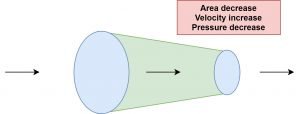- Volume flow rate
- Volumetric flow rate equation
- Volumetric flow rate symbol
- Volumetric flow rate units
- Volumetric flow rate to mass flow rate
- Volumetric flow rate to velocity
- Volumetric flow rate to molar flow rate
- FAQs
Volume flow rate
The volumetric flow rate (volume flow rate, rate of fluid flow) is defined as the fluid volume passed per unit time through fluid flowing body such as pipes, channel, river canal etc.); In hydrometry, it is acknowledged as discharge.
Generally, the Volume flow rate is denoted by the symbol Q or V. The SI unit is m3/s. The cubic centimetres per minute is also used as unit of volume flow rate in small scale flow
Volumetric flow rate is also measured in ft3/s or gallon/min.
Volumetric flow rate is not the similar as volumetric flux, as an understanding by Darcy’s law and shown by the symbol q, the units of m3/(m2·s), that is, m·s−1(velocity). In calculation, the integration of flux over area computes the volumetric flow rate.

In the meantime, it is scalar quantity, as it is the time derivative of volume only. The variation in volume flows thru an area would be zero for steady state flow situation.
Volumetric flow rate equation
Volumetric flow rate expresses the volume that those molecules in a fluid flow occupy in a given time.
Q (V) = A v
The given equation is only valid for flat, plane cross-sections. Generally, in curved-surface the equation turn out to be surface integrals.
Q (V) = volumetric flow rate (in m3/s), l/s, l/min (LPM)
A – Cross sectional area of pipe or a channel (m2)
v – Velocity (m/s, m/min, fps, fpm etc.
As gases are compressible, volumetric flow rates can change substantially when subjected to pressure or temperature variations; that is why it is important to design thermal equipment or processes and chemical processes.
Volumetric flow rate symbol
The symbol of the volumetric flow rate is given as V or Q
Volumetric flow rate units
The unit of volumetric flow rate is given as (in m3/s), l/s, l/min (LPM), cfm, gpm
Volumetric flow rate to mass flow rate
The variation between mass flow and volumetric flow relates to the density of what you are moving. We focus on which one we focus on is determined by the concern of the problem. For example, if we are developing a system for use in a hospital, it could be moving water or moving blood. Since blood is denser than water, the same volumetric flow would result in a higher mass flow if the fluid was blood than if it was water. Conversely, if the flow resulted in a specific amount of mass being moved in a specific time, more water would be moved than blood.
Volumetric flow rate to velocity
If we see the volumetric flow unit, it is m3/s, and the unit of velocity is m/s. So if we want to convert volumetric flow rate into velocity. We divide the volumetric flow rate by the cross-sectional area from which fluid is flowing. Here, we have to take an area of a cross-section of pipe from which liquid is flowing.
In short, if we want to find a velocity from volumetric flow, we have to divide the volumetric flow by cross-section area of pipe or duct from which it is flowing.
Unit of volumetric flow m3/s
Unit of area m2
Unit of velocity =
Unit of velocity =(m^3/s)/m^2 =m/s
Volumetric flow rate to molar flow rate
You know Molar flow rate (n) is defined as the no. of moles in a solution/mixture that pass thru the point of measurement per unit of time
Whereas, Volumetric flow (V) rate is the volume of fluid pass thru the measurement point per unit time.
Both these are connected by an equation
? (density of the fluid) = n/V
FAQs
What is meant by flow rate?
Let’s first, we need to know that there are two types of flow rates: mass and volumetric.
Both flow rates are used to know how much fluid passes through a pipe section per unit of time. The mass flow rate measures the flowing mass, and the volumetric flow rate is measuring the volume of flowing fluid.
If the fluid is incompressible in nature, like liquid water at normal conditions, both quantities are proportional, employing the fluid’s density.
These flow rates are helpful in many important fluid dynamics calculations, so I am delighting one of the application: continuity equation.
The continuity equation states in a pipe with waterproof walls where an incompressible fluid flows, the volumetric flow rate is constant in all the pipe sections.
Flow rate calculation using pressure
In cases like flow nozzles, venturi and orifice, the flow is depend to ΔP (P1-P2) by the equation:
Q = CD π/4 D22 [2(P1-P2) / ρ(1 – d4) ]1/2
Wherever:
Q –> flow in m3/s
CD –> discharge coefficient = A2/A1
P1 and P2 –> in N/m2
ρ –> fluid density in unit kg/m3
D2 –> The inside diameter of nozzles (in m)
D1 –> The inlet and outlet pipe diameter (in m)
and d = D2/D1 diameter ratio
Can I add two different volumetric flow rate of the same gas that came from two different pipes and were measured at different conditions?
If we consider several situations, the answer is yes. Let’s see what those situations are? The pressure in the pipeline should be relatively minimal. There is no change in density because of pressure variation. The flow measuring device should be installed far from the pipe’s junction to avoid beck pressure interference.
When would the maximum volumetric flow rate occur through a pump, And why?
If we consider a centrifugal pump, the pump’s volumetric flow rate is directly proportional to the impeller’s speed and a cube of impeller diameter. So, if we increase the speed for a given pump, we will get a high flow rate. Otherwise, if we concentrate on diameter, we can install a big pump to get a high flow rate. It is also possible to get a high flow rate by installing several pumps in parallel. Remember each pump must develop the same head at the discharge; otherwise, backflow to another pump may occur.
But all those solutions are based on theoretical considerations. If you are supposed to do that in an actual plant, then there must be many constraints that you have to consider!
For example, you should consider the cost of a pump, space consumptions etc.
How do you convert a molar flow rate into a volumetric flow rate?
Both these are connected by an equation
? (density of the fluid) = n/V
Why is it that the inlet’s volumetric flow rate is not equal to that at an exit under steady-state conditions?
If the flow is incompressible and non-reacting, then it can be possible that volumetric flow is not the same as in inlet and outlet. Other might be the law of conservation of mass has to be fulfilled.
Is there a relationship between pressure and volumetric flow rate in the air?
For that relation we may look for “Hagen-Poiseuille relation”, the pipe flow rate is related to pipe size, the fluid properties and ΔP has been explained.
It is derived from Navier-Stokes’s equations, so it is a momentum balance.
∆P=128μLQ/(πd^4 )
ΔP is the pressure drop [Pa]
μ is the fluid viscosity [Pa⋅s]
L equal to pipe length [m]
Q will be the volume flow rate in [m3/s]
d is the dia of pipe [m]
Why does the head of a pump decrease with the volumetric flow rate?
It is actually easier to visualise if you switch them around. As the head that the pump has to work against goes down, the volume that it discharges goes up (for a centrifugal pump at a given speed).
Essentially, the pump imparts energy to the fluid at a fixed rate (ignoring efficiencies for a moment). That energy can be produced as potential energy (head) or kinetic energy (volumetric flow rate), or any combination up to the total amount of energy.
It’s similar to pushing a heavyweight up a ramp. The steeper the ramp, the less weight you can push-ups it.
What is the difference between volumetric flux and velocity in porous medium flow?
Volumetric flux is the volume of fluid flowing through a unit surface in unit time, whereas velocity is the distance travelled by the fluid from two-unit time points.
The unit of volumetric flux and velocity is the same.
In the case of a porous medium, the volumetric flux will be less than or equal to(less likely to be equal) than the velocity of the flow, depending on the medium’s porosity.
Does waterfall down a vertical pipe accelerate at g? I want to calculate the volumetric flow rate of water at the bottom of an 85m tall vertical pipe?
It depends on the friction factor of the pipe. The friction factor depends on the roughness of the pipe and Reynold number. The friction is resistance to the water flow. It means that friction is reducing the acceleration. If we consider friction is zero, then acceleration is equal to g.
A continuous flow of water would be established along the pipe. Thus, it would not matter, as the average velocity would be the same as at the top of the pipe or midway.
If you want to calculate the volumetric flow rate of water at the bottom of the pipe, you need to calculate the velocity and multiply by the pipe’s cross-sectional area.
if we ignore friction, the average velocity at the bottom is given by
v=√2gh
The loss of energy can be found in the moody diagram.
How does a valve affect volumetric flow rate without violating conservation of mass?
As we know that volumetric flow rate is the multiplication of velocity and cross-sectional area from which the flow is flowing. In the case of the valve, the cross-sectional area is affected. The cross-sectional area’s change is varying the velocity of flowing fluid, but the overall volume flow rate remains the same. The conservation of mass principle is satisfied. As per Bernoulli’s principle, we know that reducing cross-sectional area kinetic energy is converted into pressure energy.

foe more article click here

I am Deepak Kumar Jani, Pursuing PhD in Mechanical- Renewable energy. I have five years of teaching and two-year research experience. My subject area of interest are thermal engineering, automobile engineering, Mechanical measurement, Engineering Drawing, Fluid mechanics etc. I have filed a patent on “Hybridization of green energy for power production”. I have published 17 research papers and two books.
I am glad to be part of Lambdageeks and would like to present some of my expertise in a simplistic way with the readers.
Apart from academics and research, I like wandering in nature, capturing nature and creating awareness about nature among people.
Also refer my You-tube Channel regarding “Invitation from Nature”